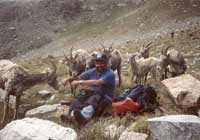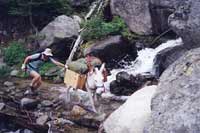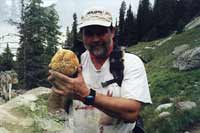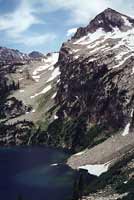| A SPIN IN THE WILDERNESS | ||
|
Roger Badash "Damn! You boys need a new trailer." The welder stood in the doorway of his shop and gave us the bad news. High and dry on a hot noonday in Belgrade, Montana, with broken steel and a sagging axle. Three guys a thousand miles from home with a few hundred pounds of gear and two burros -- a little much to hitchhike with down the Interstate. Then the circles started overlapping. Gus Foster, panoramic photographer, originally hails from Wisconsin. Well, it turns out, so does the husky owner of B&W Welding and his husky son. And what town are you from? "Wausau," came two simultaneous answers, from Gus and the welder. We were all smiling now. When it turned out that both men were married in the chapel of St. Mary's Hospital in Wausau and have the same favorite sausage shop on Sixth Street, we were in solid. The floor jacks rolled out, the welding rods began sparking, and while the burros nibbled the parking lot weeds, the Foster Project got patched up and on the road, saving both the trailer and the season's trip. Such welcome seems to be the rule, not the exception, when it comes to Gus Foster's twenty-year odyssey with camera, roaming the high ground of America. The quest for the peaks and promontories of the Continental Divide winds through many valleys, across borders, beside rivers. It rolls down highways and up trails, but is always carried along by the people of the mountains, capturing imaginations and opening doors (and gates) throughout the West. Still friendly after all these years. Our paths first crossed when Gus Foster came calling in 1979 in search of some pieces of the handmade furniture I was making back then. My country road was at its temporary impassable stage in the soggy end of March, and his vehicle was stuck to the axles in mud a mile from the house, with the sun going down. No assistance available until daylight.
With no other possibilities open to him, Gus became our guest, compelled to stay for dinner and the night. By morning my family and I had learned that he had a unique, but cumbersome, antique box camera that could shoot a 360 degree image from the top of my nearest and favorite mountain, the 12,800 foot Jicarita Peak in the Pecos Wilderness of northern New Mexico. Conveniently, I had revealed in turn that I owned a trio of energetic, but independent-minded pack burros that could facilitate getting said camera onto said peak. (Warning: moving large loads via burro over primitive trails may result in loss of some skin and all patience, according to the Surgeon General.) I became Gus Foster's climbing companion.
Neither of us realized at the time that watching a camera spin, high up in the mountains somewhere across ten Western states, would become the prime focus of Gus's life for the next twenty years. After our first climb together he spent the next several climbing seasons exploring the Rio Grande gorge and the peaks and mesas of the Sangre de Cristos, while also exploring panoramic photographic technique with the stately black-and-white format of the old Cirkut camera.
While exceedingly light, simple, and color capable, the Globuscope and its 35mm design was still somewhat restrictive for the size of photographic print Gus envisioned developing from his exposed film. Capturing powerfully large images, with some approximation of the humbling scale of the environment, in true color and on modern film, called for a Big Gun from the late, not early, twentieth century. The black-and-white Cirkut would not do, neither would the small format Globuscope. Gus returned home to Taos from a trip to New York bringing just such a tool, a Globus-Holway Panoramic Scanning Camera, a large- format, highly-engineered device capable of producing wall-size prints of crystal clarity. Sometimes. Pros: big negative gives great detail, camera fits into one (large) backpack load, spins smoothly with battery/motor drive plate (no chattering gear), can be occasionally repaired in the field. Cons: never intended for back country travel, the loaded backpack is REALLY HEAVY, sometimes does not spin smoothly or even spin at all, needs occasionally to be repaired in the field. Summary #1: the Globus-Holway Panoramic Scanning Camera can take huge and stunning photographs encompassing tremendous vistas in remote settings. Summary #2: the occasional fickleness of this camera when placed in the unpredictable mountain setting can result in ruined (or no) photographs. (Warning: situations resulting in Summary #2 may produce monstrous oaths and the thrashing of nearby inanimate objects by the photographer.) The exciting news now is Gus's newest camera, a computerized small wonder custom-made by a Taos inventor that promises more flexibility and toughness in the wilderness.
Deep booms of thunder blowing in drove us to an instant camp on the least-tilted piece of mountainside we could find in the gloom. We staked down the tent in the whipping rain, dove inside and tried to get warm in our sleeping bags; we dozed, thankful to be out of the elements. Suddenly the world turned pure white as deafening crashes exploded through the treetops above us. Joseph sat bolt upright, shouting "Dad!" as the intense light filled the tent with macabre detail, then disappeared, strobing over and over with each simultaneous thunderclap. Throughout the night we huddled and shrank into ourselves, unable to ignore the rolling waves of sound that shuddered the ground we lay on. In the soggy but clear morning, a bank of fresh snow pushed against the uphill wall of the tent while water streamed and streamed down the mountain under a pale sky. We regained the trail above and reached the lakes before noon, but the rock above was wet and shiny with new snow and ongoing runoff, discouraging any attempt to get the camera on the summit. Gus set up his gear for a lakeshore panorama, but moments before the camera spun, Joseph called "Wait!" A basketball-size piece of bubble wrap floated about thirty feet out on the lake's surface; it had blown unnoticed from the camera pack and stuck out like a beacon in the dark water. The combination of trees, lake, peaks, and a big wad of shiny plastic somehow didn't seem to fit right in a Foster wilderness picture. We helplessly watched the wrapping bob merrily away as new clouds began sailing in over the peaks, narrowing the time in which it was possible to capture the scene with acceptable photographic light. The wind picked up and suddenly began working for us, as the increasing ripples on the lake carried the plastic toward a rock outcropping on the opposite shore. Joseph and I ran around the lake and, by lying flat on a partially-submerged boulder and extending a branch, were able to make a snag. Holding the dripping prize, we concealed ourselves behind the rocks as Gus raced the incoming weather to get the shot. With jackets on and collars up, we repacked the camera, loaded the burros and beat it out of the lake basin and back over the divide, heading down the twelve miles of trail that would return us to the road. Hours later, a certain ten-year-old fell asleep into his dinner plate. All in a day's work when your boss is a camera.
Since Gus knew he'd be shooting the Divide in the Aldo Leopold Wilderness Area of New Mexico in the near future, meeting Aldo Leopold's son Luna was an unexpected treat, verging on a sacred honor. Aldo, an ardent conservationist, was instrumental in creating America's National Forest system in the 1920s, and the remote and rugged wilderness in New Mexico's Black Range in the Gila Forest was named after him. Luna is a retired geologist/hydrologist who taught at the University of California at Berkeley and worked with the United States Geologic Survey in many Western mountain ranges. He keeps a summer home in Pinedale near "his" Winds. Although his own packing days are behind him, the Professor had a trove of information and answers for our eager questions about the terrain we'd be covering in the next days in the Winds, as well as an interest in ex changing news about our homes far to the south. Feeling sustained from the meal and enthused from making a link through the Leopolds to an earlier era in the Rockies, Gus and company hit the trail early next morning in the direction of Indian Lake and Gus's chosen destination: Jackson Peak, named for the pioneering photographer of the 1870s, William Henry Jackson. At the end of a second day of hiking the trail forked and required a commitment to either Jackson Peak or Fremont Peak. The burros made the call by balking at the fourth stream crossing of the afternoon, despite all yankings, heavings, and switchings; they forced the party to take the Fremont campsite. From a high vantage point the next day, we realized that had the burros crossed that fourth stream, the Jackson route would have been impassable later on due to deep snow, which was unobservable from below. Animal trail intuition or downright plain feistiness? In the mountains or in Las Vegas, there are no odds given for predicting the mind of the burro. Just tie it on and let 'em roll. What Luna Leopold had not prepared us for was the ferocity of the hail storm that pounded the high country before sunset. The animals had no alternative other than to turn their rumps into the gale and take a licking. We humans rode out the tempest under our protective skin of nylon and watched the tent floor ripple and burble up beneath us as more water than the mountain could handle ran off the Winds' western slope in a rush to join the Green River miles to the west. The rewards came the next day when the camera spun atop 13,756-foot Fremont Peak, overlooking the glacier to the east, Jackson Peak to the south, and Wyoming's highest, Gannett Peak, to the north. We shared the summit with climbers from California, Colorado, and Ohio, who obligingly hid from sight during the camera's revolutions. We were especially pleased to find that one of the Californians was further along in his fifties than anyone in our group. There was still hope!
Not only did the location of the rampart elude Gus and camera, the summit of Cloud Peak proved elusive as well. The approach, five miles of jumbled boulders, was well-described in the guidebook, but reading about it and walking on it were two very different propositions. This was one of the first real outings for William, Gus's newly acquired Alpine-La Mancha pack goat, who was along to carry the camera in places where burros fear to tread. About halfway through the boulder field, William decided that he too feared to tread, which required him to be staked out to wait while the humans humped the camera upward. A good hour spent cowering under a skimpy rock slab, as waves of thunder and yet more Wyoming hail blew through, made time run out. From a bare ridge of dark rock 800 feet below the top, Gus got a photo of the summit instead of a photo from the summit. In the falling temperature we scrambled downward across alternating sections of snowfield and boulders to pick up William from Goat Parking and get to camp. I guess some of us were a little slow to grasp why a mountain might be named Cloud Peak. Maybe next time, Professor. Walking out of the Bighorns, we encountered numerous fishermen-and-women trying the lakes along the trail, typical of the thousands who visit the wilderness. I was reminded that Gus and camera have met anglers along some of the West's prettiest waters. Although Oregon's beautiful Wallowa Lake was crowded with fishing lines during the nearby town's Old Chief Joseph Days in August, its smaller cousin Ice Lake, 2,000 feet higher in the Eagle Cap Wilderness, lay quiet for those like us who made the effort to get there. At Wyoming's Glendoe Reservoir, far from any ocean, sunset fishermen competed with skimming gulls and pelicans on the big water, which is fed by the North Platte River coming out of both the Mt. Zirkel Wilderness and Rocky Mountain National Park in northern Colorado. A visiting rockhound from Casper showed us to a little beach made of thousands of shards of petrified wood. We ended the day with a cool swim under the sky's last pink rays.
Bighorn sheep and distant grazing elk have been caught in the camera's eye, as have numerous marmots and picas in their rocky homes above the tree line. Deer have wandered through camp at twilight, while industrious squirrels and chipmunks have found their way into the stacked-and-tarped supply pile to invade the granola stash, nibble tortillas, or gnaw sweat-stained saddle leather for salt. Mountain goats have run from our approaching footsteps in the Pioneer Range in Montana and a moose and her calf have eyed us warily from a bog in the High Uintas in Utah. And so far, although we have known we were sharing the neighborhood, Brother Bear has yet to pay us a visit. (But it's OK, Brother, really -- we know you're a busy guy.)
In New Mexico, on a blustery October evening at 11,500 feet in the Pecos, Gus strengthened the camp with his super-thick beef, sausage, and potato stew, which he'd pre-frozen into quart cubes and packed in the wooden burro panniers. The bubbling stew was served with campfire-toasted tortillas and sliced fruit. He finished us off with cocoa-and-rum all around, JUST what the doctor ordered. It's another winner! I pledge allegiance to the flag of my sleeping bag. Gus has presented London Broil on the grill and fresh corn in the husks from the coals. We've seen asparagus in butter, tart cucumber salads, and a mean heat-generating curried rice, all prepared in a slightly-dented minimalist trio consisting of one deep pot and two skillets. And, surprisingly often, there is a welcome addition of fresh-picked produce du jour that Gus has gathered along the way: mushrooms such as boletus and chanterelles, wild onions, various berries, all served in, on, or next to that night's specialty. Indeed, the Gus Dinner is now viewed as one of the prime motivational factors for the support team in getting the camera onto the mountain. So better keep stirring and simmering, Gus. Lose your Michelin outdoor rating and who knows? It could get mighty lonesome in that wilderness! For the last twenty years, at least, the Photographer has been well-fixed for mountain company. Gus has traveled with a small circle of mountaineers from New Mexico and Colorado, and a large Swedish climber who helped get the camera onto Riggs Glacier for a week in Alaska. He's trekked with his sister, his nephews, some old friends, and lately, some of the children of his old friends, whose twenty-something energy for firewood gathering and burro wrangling makes them HIGHLY DESIRABLE potential camp mates, especially when weighed against their aching-back, trail-weary parents. Hey, it's a forest out there.
pictured above: Jicarita Peak, 1979, Sangre de Cristo Range, Pecos Wilderness, New Mexico, 360 degree panoramic photograph, Photo by Gus Foster14
Big Horn Sheep, 1989 Pecos Wilderness, New Mexico Photo by Roger Badash
John Chamberlain and Sid at Rock Creek, 1995, Absaroka-Beartooth Wilderness, Montana. Photo by Gus Foster
Fresh Boletus mushrooms, 1997, Big Horn Mountains, Wyoming, Photo by Roger Badash
North End of Sawtooth Lake, 1996, Sawtooth Wilderness, Photo by Roger Badash
Camp Kitchen -- Steak and Wild Mushrooms, New Mexico 1998. Photo by Gus Foster | ||
| [ HOME THE AMERICAN ROCKIES INDEX ] email © Gus Foster | ||

 Summer, 1986. Gus, my ten-year-old son Joseph, and I were trying to get the Globus-Holway and our camp gear up the Santa Barbara Divide and on to Truchas Peak, elevation 13,102 feet, in the Pecos Wilderness. Our temperaments and our endurance were wearing a little thin following an afternoon of walking in the rain. The morning had included lost trails and bog-stuck burros, with a quick chilling squall and marginal hypothermia (my own) thrown in to the day's pot of exasperations. As darkness came on and we consulted the map, we knew we were close to 12,000 feet elevation, in the fog, and somewhere on planet Earth.
Summer, 1986. Gus, my ten-year-old son Joseph, and I were trying to get the Globus-Holway and our camp gear up the Santa Barbara Divide and on to Truchas Peak, elevation 13,102 feet, in the Pecos Wilderness. Our temperaments and our endurance were wearing a little thin following an afternoon of walking in the rain. The morning had included lost trails and bog-stuck burros, with a quick chilling squall and marginal hypothermia (my own) thrown in to the day's pot of exasperations. As darkness came on and we consulted the map, we knew we were close to 12,000 feet elevation, in the fog, and somewhere on planet Earth. However, the mountains must be shared to be seen, seen to be appreciated, and appreciated to be preserved. With this spirit in mind, the Photographer smilingly explained his equipment and the panoramic process to the boys and their troop leaders while the wind whistled through the fractured slabs of sandstone at our feet. His friend and frequent climbing partner, Santa Fe educator John Chamberlain, assisted as the scouts peered through the lens with Gus. They lined up landmarks in the distance with help from John and his maps, and finally left the mountaintop seeing and knowing more than when they arrived. A little bit of "passing the torch" had taken place. If, in the future, wilderness has a chance for preservation, the young people we encounter in the mountains today will likely be the conservators of tomorrow.
However, the mountains must be shared to be seen, seen to be appreciated, and appreciated to be preserved. With this spirit in mind, the Photographer smilingly explained his equipment and the panoramic process to the boys and their troop leaders while the wind whistled through the fractured slabs of sandstone at our feet. His friend and frequent climbing partner, Santa Fe educator John Chamberlain, assisted as the scouts peered through the lens with Gus. They lined up landmarks in the distance with help from John and his maps, and finally left the mountaintop seeing and knowing more than when they arrived. A little bit of "passing the torch" had taken place. If, in the future, wilderness has a chance for preservation, the young people we encounter in the mountains today will likely be the conservators of tomorrow. After subsequent correspondence, Luna Leopold encouraged Gus's already formative plan to visit another Wyoming rock fortress two years later, Cloud Peak in the Bighorn Mountains. The Prof had seen an unusually big "protalus rampart" in the 1950s and hoped we could get a picture of it. The rampart, located in a bowl somewhere on the trackless northeast slopes of Cloud Peak, is apparently a 100-foot-tall pile of stones left over from the end of the last Ice Age and something that may require a geology degree to love.
After subsequent correspondence, Luna Leopold encouraged Gus's already formative plan to visit another Wyoming rock fortress two years later, Cloud Peak in the Bighorn Mountains. The Prof had seen an unusually big "protalus rampart" in the 1950s and hoped we could get a picture of it. The rampart, located in a bowl somewhere on the trackless northeast slopes of Cloud Peak, is apparently a 100-foot-tall pile of stones left over from the end of the last Ice Age and something that may require a geology degree to love. Gus has met the fishing hopeful at Sawtooth Lake, nestled beneath the rugged peaks in Idaho, and at Green Lake in Wyoming at the northern end of the Winds, source of the mighty Green River. The camera has traveled past others who were hitting the pools from the safety of the bank in white water streams like Montana's Rock Creek in the Absarokas and the Gallatin River in the Madison Range, or wading into the classic, broad fly-fishing waters of the Big Hole and Bitterroot Rivers to the west.
Gus has met the fishing hopeful at Sawtooth Lake, nestled beneath the rugged peaks in Idaho, and at Green Lake in Wyoming at the northern end of the Winds, source of the mighty Green River. The camera has traveled past others who were hitting the pools from the safety of the bank in white water streams like Montana's Rock Creek in the Absarokas and the Gallatin River in the Madison Range, or wading into the classic, broad fly-fishing waters of the Big Hole and Bitterroot Rivers to the west. We sat one summer evening on a high bank above the Payette River in Idaho's Sawtooth Range watching kayakers slide past. Gus steamed fresh Pacific mussels on the camp stove, laid out salad greens and hard baguettes, and filled the Sierra cups with wine. Not bad for the woods . . . The feast was followed by the ultimate dessert: two cookies and a dry sleeping bag. This guy knows what we want!
We sat one summer evening on a high bank above the Payette River in Idaho's Sawtooth Range watching kayakers slide past. Gus steamed fresh Pacific mussels on the camp stove, laid out salad greens and hard baguettes, and filled the Sierra cups with wine. Not bad for the woods . . . The feast was followed by the ultimate dessert: two cookies and a dry sleeping bag. This guy knows what we want!